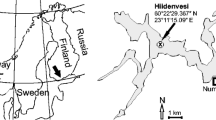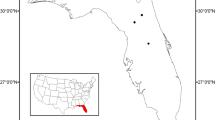Abstract
We retrieved four sediment cores from shallow, eutrophic, macrophyte-dominated Orange Lake (A = 51.4 km2, zmax <5 m, zmean < 2 m), north-central Florida, USA. The 210Pb-dated profiles were used to evaluate spatial and temporal patterns of bulk sediment and nutrient accumulation in the limnetic zone and to infer historical changes in lake trophic state. Bulk density, organic matter, total carbon, total nitrogen, total phosphorus and non-apatite inorganic phosphorus (NAIP) concentrations displayed stratigraphic similarities among three of four cores, as did accumulation rates of bulk sediment, organic matter and nutrients. Accumulation rates were slower at the fourth site. Nutrients showed generally increasing rates of accumulation since the turn of the century. Percentages of periphytic diatom taxa increased progressively in the cores after ~ 1930. Diatom-inferred limnetic total P trends were similar among profiles. Eutrophic conditions were inferred for the period prior to the turn of the century. The lake was hypereutrophic in the early decades of the 1900s, but inferred limnetic total P values declined after ~ 1930. Declining inferred limnetic total P trends for the last 60--70 years were accompanied by concomitant increases in accumulation rates of total P and NAIP on the lake bottom. Several lines of evidence suggest that after ~ 1930, phosphorus entering Orange Lake was increasingly utilized by submersed macrophytes. Paleolimnological records from Orange Lake highlight the importance of using multiple sediment variables to infer past trophic state and suggest that aquatic macrophytes can play a role in regulating water-column nutrient concentrations in shallow, warm-temperate lakes.
Similar content being viewed by others
References
Abbasi, S.A., P.C. Nipaney & G.D. Schaumberg, 1990. Bioenergy potential of eight common aquatic weeds. Biol. Wastes 34: 359-366.
Anderson, N.J., B. Rippey & C.E. Gibson, 1993. A comparison of sedimentary and diatominferred phosphorus profiles: implications for defining predisturbance nutrient conditions. Hydrobiologia 253: 357-366.
Appleby, P.G. & F. Oldfield, 1983. The assessment of 210Pb data from sites with varying sediment accumulation rates. Hydrobiologia 103: 29-35.
Appleby, P.G., P.J. Nolan, D.W. Gifford, M.J. Godfrey, F. Oldfield, N.J. Anderson & R.W. Battarbee, 1986. 210Pb dating by low background gamma counting. Hydrobiologia 143: 21-27.
Bennion, H., 1995. Surfacesediment diatom asemblages in shallow, artificial, enriched ponds, and implications for reconstructing trophic status. Diatom Res. 10: 1-19.
Best, E.P.H., J.H.A. Dassen, J.J. Boon & G. Wiegers, 1990. Studies on decomposition of Ceratophyllum demersum litter under laboratory and field conditions: losses of dry mass and nutrients, qualitative changes in organic compounds and consequences for ambient water and sediments. Hydrobiologia 194: 91-114.
Binford, M.W., 1990. Calculation and uncertainty analysis of 210Pb dates for PIRLA project lake sediment cores. J. Paleolim. 3: 253-267.
Binford, M.W. & M. Brenner, 1986. Dilution of 210Pb by organic sedimentation in lakes of different trophic states, and application to studies of sedimentwater interactions. Limnol. Oceanogr. 31: 584-595.
Bradbury, J.P., 1977. Diatom stratigraphy and human settlement in Minnesota. Geol. Soc. Am. Spec. Paper 171, 74pp.
Brenner M. & M.W. Binford, 1988. Relationships between concentrations of sedimentary variables and trophic state in Florida lakes. Can. J. Fish. Aquat. Sci. 45: 294-300.
Brenner, M., M.W. Binford & E.S. Deevey. 1990. Lakes. In: Myers, R.L. and J.J. Ewel (eds), Ecosystems of Florida. University of Central Florida Press, Orlando, 364-391.
Brenner, M., T.J. Whitmore, M.S. Flannery & M.W. Binford, 1993. Paleolimnological methods for defining target conditions in lake restoration: Florida case studies. Lake and Reserv. Manage. 7: 209-217.
Brenner, M., A.J. Peplow & C.L. Schelske, 1994. Disequilibrium between 226Ra and supported 210Pb in a sediment core from a shallow Florida lake. Limnol. Oceanogr. 39: 1222-1227.
Brenner, M., T.J. Whitmore, J.H. Curtis & C.L. Schelske, 1995. Historical ecology of a hypereutrophic Florida lake. Lake and Reserv. Manage. 11: 255-271.
Brenner, M., T.J.Whitmore & C.L. Schelske, 1996. Paleolimnological evaluation of historical trophic state conditions in hypereutrophic Lake Thonotosassa, Florida, USA. Hydrobiologia 331: 143-152.
Brenner, M., C.L. Schelske & T.J. Whitmore, 1997. Radium226 stratigraphy in Florida lake sediments as an indicator of human disturbance. Verh. Internat. Verein. Limnol. 26: 809-813.
Brooks, H.K., 1981. Guide to the physiographic divisions of Florida. Florida Cooperative Extension Service, Institute of Food and Agricultural Sciences. Univ. Florida, Gainesville, FL.
Canfield, D.E. Jr. & J.R. Jones, 1984. Assessing the trophic status of lakes with aquatic macrophytes. Lake and Reserv. Manage.. Proceedings of the Third Annual Conference of the North American lake Management Society (US EPA). Pp. 446-451.
Canfield, D.E. Jr., K.A. Langeland, M.J. Maceina, W.T. Haller, J.V. Shireman & J.R. Jones, 1983a. Trophic state classification of lakes with aquatic macrophytes. Can. J. Fish. Aquat. Sci. 40: 1713-1718.
Canfield, D.E. Jr., M.J. Maceina & J.V. Shireman, 1983b. Effects of hydrilla and grass carp on water quality in a Florida lake. Wat. Res. Bull. 19: 773-778.
Canfield, D.E. Jr., J.V. Shireman, D.E. Colle, W.T. Haller, C.E. Watkins II & M.J. Maceina, 1984. Prediction of chlorophyll a concentrations in Florida lakes: importance of aquatic macrophytes. Can. J. Fish. Aquat. Sci. 41: 497-501.
Carrick, H.J., F.J. Aldridge & C.L. Schelske, 1993. Wind influences phytoplankton biomass and composition in a shallow, productive lake. Limnol. Oceanogr. 38: 1179-1192.
Colle, D.E., J.V. Shireman, W.T. Haller, J.C. Joyce & D.E. Canfield Jr., 1987. Influence of hydrilla on harvestable sportfish populations, angler use, and angler expenditures at Orange Lake, Florida. North Amer. J. Fish. Manage. 7: 410-417.
Dieter, C.D., 1990. The importance of emergent vegetation in reducing sediment resuspension in wetlands. J. Freshwat. Ecol. 5: 467-473.
Fisher, M.M., M. Brenner & K.R. Reddy, 1992. A simple, inexpensive piston corer for collecting undisturbed sediment/water interface profiles. J. Paleolim. 7: 157-161.
Florida Lakewatch, 1995. Florida Lakewatch Data-1995. Department of Fisheries and Aquatic Sciences, Univ. Florida, Gainesville. 400 pp.
Florida Lakewatch, 1996. Florida Lakewatch Data 1986-1996. Department of Fisheries and Aquatic Sciences, Univ. Florida, Gainesville. 1108 pp.
Fritz, S.C., J.C. Kingston & D.R. Engstrom, 1993. Quatitative trophic reconstruction from sedimentary diatom assemblages: a cautionary tale. Freshwat. Biol. 30: 1-23.
Gasaway, R.D. & T.F. Drda, 1978. Effects of grass carp introduction on macrophytic vegetation and chlorophyll content of phytoplankton in four Florida lakes. Florida Sci. 41: 101-109.
H°akanson, L. & M. Jansson. 1983. Principles of lake sedimentology. SpringerVerlag, NY, 316 pp.
Hall, R.I. & J.P. Smol, 1992. A weightedaveraging regression and calibration model for inferring total phosphorus concentration from diatoms in British Columbia (Canada) lakes. Freshwat. Biol. 27: 417-434.
Huber, W.C., P.L. Brezonik, J.P. Heaney, R.E. Dickinson, S.D. Preston., D.S. Dwornik & M.A. DeMaio, 1982. A classification of Florida lakes. Report ENV05821 to the Florida Department of Environmental Regulation, Tallahassee, FL.
Hustedt, F., 1930-1966. Die Kieselalgen Deutschlands, ¨Osterreichs und der Schweiz. In: Dr. L. Rabenhorst's Kryptogamen Flora von Deutschlands, ¨ Osterreichs und der Schweiz. Band 7. Teil 1-3.
Knoll, G.E., 1989. Radiation detection and measurement. 2nd Edition. J. Wiley & Sons, NY, 762 pp.
Krishnaswami, S. & D. Lal, 1978. Radionuclide limnochronology. In: Lerman, A. (ed), Lakes: chemistry, geology, physics. SpringerVerlag, NY: 153-177.
Lasi, M.A., J. Shuman, J. Bryan, K.Warr & M. Tepera, 1996. Orange Creek Basin Surface Water Management Plan. St. Johns River Water Management District, Palatka, FL. 280 p. + appendix.
Maceina, M.J. & D. M. Soballe, 1990. Windrelated limnological variation inLakeOkeechobee, Florida. Lake and Reserv. Manage. 6: 93-100.
Marth, D. & M.J. Marth (eds), 1990. Florida Almanac, 1990-1991. Pelican Publishing Co., Gretna, LA. 410 pp.
Oldfield, F. & P.G. Appleby, 1984. Empirical testing of 210Pbdating models for lake sediments. In: Haworth, E.Y. & J.W.G. Lund (eds), Lake sediments and environmental history. Leicester University Press, Leicester: 93-124.
Patrick, R. & C.W. Reimer, 1966-1975. The Diatoms of the United States. Monogr. Acad. Sci. Phila., No. 13, Part 1, v. 1-2.
Schelske, C.L., D.J. Conley, E.F. Stoermer, T.L. Newberry & C.D. Campbell, 1986. Biogenic silica and phosphorus accumulation in sediments as indices of eutrophication in the Laurentian Great Lakes. Hydrobiologia 143: 79-86.
Schelske, C.L., A. Peplow, M. Brenner & C.N. Spencer, 1994. Lowbackground gamma counting: applications for 210Pb dating of sediments. J. Paleolim. 10: 115-128.
Shireman, J.V., W.T. Haller, D.E. Colle, C.E. Watkins, III, D.F. DuRant & D.E. Canfield Jr., 1983. Final Report: Ecological impact of integrated chemical and biological aquatic weed control. Univ. Florida, Center for Aquatic Weeds, Gainesville, FL.
Sondergaard, M., J. Windolf & E. Jeppesen, 1996. Phosphorus fractions and profiles in the sediment of shallow Danish lakes as related to phosphorus load, sediment composition and lake chemistry. Wat. Res. 30: 992-1002.
Takamura, N. & T. Iwakuma, 1991. Nitrogen uptake and C:N:P ratio of epiphytic algae in the littoral zone of Lake Kasumigaura. Arch. Hydrobiol. 121: 161-170.
Van der Werff, 1955. A new method of concentrating and cleaning diatoms and other organisms. Int. Ver. Theor. Angew. Limnol. Verh. 12: 276-277.
Whitmore, T.J., 1989. Florida diatom assemblages as indicators of trophic state and pH. Limnol. Oceanogr. 34: 882-895.
Whitmore, T.J., 1991. Sedimentary diatom concentrations and accumulation rates as predictors of lake trophic state. Hydrobiologia 214: 163-169.
Whitmore, T.J., M. Brenner & C.L. Schelske, 1996. Highly variable sediment distribution: a case for sediment mapping surveys in paleolimnological studies. J. Paleolim. 15: 207-221.
Zimba, P.V., M.S. Hopson & D.E. Colle, 1993. Elemental composition of five submersed aquatic plants collected from Lake Okeechobee, Florida. J. aquat. Plant Manage. 31: 137-140.
Author information
Authors and Affiliations
Rights and permissions
About this article
Cite this article
Brenner, M., Whitmore, T.J., Lasi, M.A. et al. A multi-proxy trophic state reconstruction for shallow Orange Lake, Florida, USA: possible influence of macrophytes on limnetic nutrient concentrations. Journal of Paleolimnology 21, 215–233 (1999). https://doi.org/10.1023/A:1008079500375
Issue Date:
DOI: https://doi.org/10.1023/A:1008079500375




